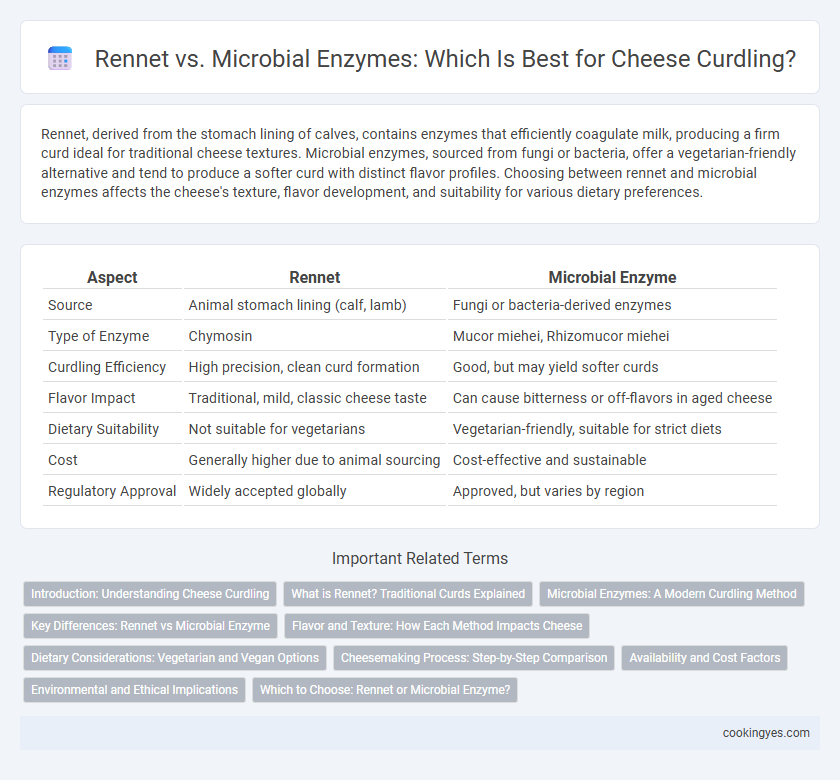Rennet, derived from the stomach lining of calves, contains enzymes that efficiently coagulate milk, producing a firm curd ideal for traditional cheese textures. Microbial enzymes, sourced from fungi or bacteria, offer a vegetarian-friendly alternative and tend to produce a softer curd with distinct flavor profiles. Choosing between rennet and microbial enzymes affects the cheese's texture, flavor development, and suitability for various dietary preferences.
Table of Comparison
| Aspect | Rennet | Microbial Enzyme |
|---|---|---|
| Source | Animal stomach lining (calf, lamb) | Fungi or bacteria-derived enzymes |
| Type of Enzyme | Chymosin | Mucor miehei, Rhizomucor miehei |
| Curdling Efficiency | High precision, clean curd formation | Good, but may yield softer curds |
| Flavor Impact | Traditional, mild, classic cheese taste | Can cause bitterness or off-flavors in aged cheese |
| Dietary Suitability | Not suitable for vegetarians | Vegetarian-friendly, suitable for strict diets |
| Cost | Generally higher due to animal sourcing | Cost-effective and sustainable |
| Regulatory Approval | Widely accepted globally | Approved, but varies by region |
Introduction: Understanding Cheese Curdling
Cheese curdling relies on enzymes that coagulate milk proteins, forming curds essential for cheese production. Rennet, traditionally derived from the stomach lining of ruminant animals, contains the enzyme chymosin, which efficiently breaks down casein proteins, creating firm curds. Microbial enzymes, produced by fungi or bacteria, offer a vegetarian alternative with varied curdling properties, impacting texture and flavor development in cheese varieties.
What is Rennet? Traditional Curds Explained
Rennet is a natural enzyme complex traditionally sourced from the stomach lining of young ruminants, used to coagulate milk and form curds in cheese making. This enzyme activates proteolytic reactions, causing casein proteins in milk to solidify, which is essential for creating the texture and structure of traditional cheeses. Understanding rennet's role helps differentiate it from microbial enzymes, which are lab-produced alternatives mimicking this natural curdling process.
Microbial Enzymes: A Modern Curdling Method
Microbial enzymes offer a modern and sustainable alternative to traditional animal-derived rennet for curdling cheese, derived from fungi and bacteria that produce chymosin, the key enzyme responsible for coagulation. These enzymes provide consistent curdling performance and are suitable for vegetarian and certain religious dietary requirements, enhancing cheese production flexibility. Their application supports scalable industrial cheese manufacturing with controlled coagulation times and high purity, meeting diverse consumer preferences.
Key Differences: Rennet vs Microbial Enzyme
Rennet, derived from the stomach lining of young ruminants, contains the enzyme chymosin which precisely targets casein proteins to create a firm curd, while microbial enzymes are produced through fermentation by fungi or bacteria and offer a vegetarian-friendly alternative with variable curdling strength. Rennet typically yields a smoother texture and superior flavor development in aged cheeses, whereas microbial enzymes may generate a slightly bitter taste and softer curds, affecting cheese quality. The choice between rennet and microbial enzymes significantly impacts cheese characteristics, production cost, and suitability for vegetarian consumption.
Flavor and Texture: How Each Method Impacts Cheese
Rennet produces cheese with a smoother, creamier texture and a complex, traditional flavor profile due to the enzymatic breakdown of casein proteins. Microbial enzymes result in a slightly tangier taste and a firmer, sometimes crumbly texture, as these enzymes tend to act less selectively on milk proteins. The choice between rennet and microbial enzymes significantly influences the cheese's final character, affecting both mouthfeel and flavor nuances.
Dietary Considerations: Vegetarian and Vegan Options
Rennet, derived from the stomach lining of young ruminants, is traditionally used for curdling cheese but is unsuitable for vegetarians and vegans due to its animal origin. Microbial enzymes, produced through fermentation by fungi or bacteria, offer a vegetarian-friendly alternative that effectively coagulates milk without animal-derived ingredients. Vegan cheese production often relies on microbial or plant-based coagulants to meet dietary restrictions while maintaining texture and flavor.
Cheesemaking Process: Step-by-Step Comparison
Rennet, derived from animal stomachs, contains specific enzymes like chymosin that efficiently coagulate milk proteins, producing a firm curd essential for traditional cheese textures. Microbial enzymes, sourced from fungi or bacteria, offer a vegetarian-friendly alternative but may result in softer curds and slightly different flavor profiles due to varied enzyme activity. During the cheesemaking process, rennet provides consistent coagulation speed and curd firmness, while microbial enzymes require careful dosage adjustments to optimize curd setting time and texture.
Availability and Cost Factors
Rennet, derived from the stomach lining of young ruminants, is traditionally preferred for cheese curdling but varies in availability due to animal-sourced limitations and seasonal factors. Microbial enzymes, produced through fermentation of fungi or bacteria, offer a more consistent, scalable supply and generally lower cost, making them popular in large-scale cheese production. Cost efficiency and ease of procurement make microbial enzymes advantageous for industrial cheese-making, while rennet remains valued for its specific curdling properties in artisanal cheese varieties.
Environmental and Ethical Implications
Rennet, traditionally sourced from the stomach lining of calves, raises ethical concerns related to animal welfare and limits options for vegetarians and vegans, while its production contributes to environmental impacts through livestock farming emissions. Microbial enzymes, derived through fermentation using fungi or bacteria, offer a more sustainable and cruelty-free alternative, reducing reliance on animal agriculture and lowering greenhouse gas emissions. Choosing microbial enzymatic curdling supports environmentally friendly practices and aligns with ethical considerations in cheese production.
Which to Choose: Rennet or Microbial Enzyme?
Choosing between rennet and microbial enzyme for curdling depends on factors like dietary preferences, cheese type, and production scale. Rennet, derived from the stomach lining of calves, offers traditional curdling with consistent texture, suitable for artisanal cheeses, while microbial enzymes, produced by fermentation of bacteria, fungi, or yeasts, provide a vegetarian-friendly alternative and are often preferred for mass production due to cost efficiency and availability. Assessing the desired flavor profile, ethical considerations, and application method helps determine the optimal curdling agent for specific cheese-making needs.
Rennet vs Microbial Enzyme for Curdling Infographic

 cookingyes.com
cookingyes.com